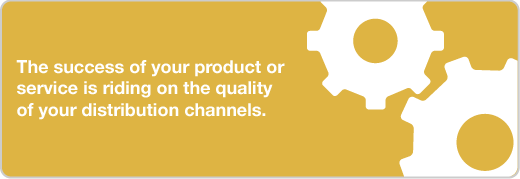
Marketing Channel Strategy & Positioning Consulting Services
Does Your Channel Marketing Strategy Have the Power to Succeed?
- Channel strategy and management
- Channel Support
- Channel Conflict
Great products only become great with great channel strategies. Your channel strategy assures:
- That your customer is aware of and understands the benefits of your product,
- That your product is present to the customer when he is ready to buy, and
- That the customer is assured of getting the post-sales support he needs when he needs this.
Great channels emerge when marketers focus on specific decisions and actions in for these four key business dimensions:
- Channel strategy and management
- Channel effectiveness / market coverage
- Conflict management
- Sustaining channels for success
Successful organizations master the skills in each of these critical channel competencies.
Channel strategy and management
Channel strategy and management brings together three key capabilities within a company:
- Channel strategy development / design
- Channel management
- Channel support
Channel strategy / design implies that you specifically know what types of channels can deliver the market segments / customers you are targeting. This would include the fact that the channels you are choosing have existing business relationships with these customer groups or that they have committed the resources to develop these relationships.
Channel strategy also implies you have developed a specific market coverage model that is appropriate for your product category — either exclusive distribution because of the very high sales cost required to develop the market, selective distribution because you see the need to have different channels for different customer segments or open distribution because your product is a commodity that everyone can sell with minimal sales effort.
Finally channel strategy implies that you have defined a level of integration between you and your channels and between channel members. Who does what in the sales process? Can the customer buy at one channel member and receive delivery from another? How will post-sales support be handled? What type of web marketing tools and sales tools will be available? Fundamentally, you are answering how independent or integrated are your channels. Today’s marketing models have become much more integrated and will need to continue on this trend to be successful.
A channel strategy is only as good as management’s ability to execute and thus goes hand in hand with channel strategy.
Channel management includes the activities to implement the channel strategy:
- Specific dealer/distributor selections
- Expectations setting and contracts
- Field sales support
- Price structure / economics that make business sense to the channel partner.
Your channel management team needs to be able to assess a channel’s ability on four key dimensions which support successful channel strategies:
- Channel Coverage measures the channels presence and importance to the target segments.
- Channel Competency is a measure of channel’s ability to deliver market share for your products.
- Channel Connection measures the channel’s ability to create and manage meaningful relationships with its customers. And,
- Channel Commitment is a measure of the channels’ willingness to work with you to support your products.
Not only do manufacturers have to develop innovative new products, they have to create high capacity channels and reduce channel conflict. The success of your product or service is riding on the quality of your channel strategy.
As tough as it is for marketing executives to make channel strategy changes, it’s even worse to jeopardize your success by running your business on cruise control. Channel assessments should be conducted on a regular basis. The manager who understands and plans for change will capture more market share. Whether the market is slowly shifting or you are driving change, ask yourself the following questions:
Coverage
Does your channel strategy give you access to each customer segment? To achieve success, you must be present at the point of sale. Do you have the ability to reach your target audience at each purchasing crossroad and at the key buying time? Are your channels calling on the right customers?
Competency
Does your channel marketing strategy have the skills and capabilities to communicate and deliver your value proposition? Value represents the benefits the customer perceives versus the total cost the customer incurs. These costs include all adoption costs, risk and the purchase price the customer pays. You “win” more when customers perceive your offer as a greater value than the alternatives.
Your channel strategy must meet the needs and expectations of your customers. Do your customers want knowledgeable sales help? Do your channels have strong pre-sales skills? What are their transaction capabilities? What about post-sale support? Your commitment to your customers extends beyond the purchase of your product.
Connection
Your channel marketing strategy must provide the customer relationships necessary to become a valued customer partner. The channels should introduce you to customers’ senior management, planning, and R&D to expand knowledge of your customers’ needs. The affiliation between your channel and customer should allow you to conduct development and product testing programs with key customers. Above all, your channel partner should not be “just another vendor.” Your goal is to develop structural and social bonds with your target customers. What role is your channel strategy playing to make this happen? Is it a help, a hindrance or not a factor at all?
Commitment
You can’t overestimate the importance of your relationship with your channel partners. Your success depends on their success. If your channels are congested with conflicting product lines, you’re not receiving the level of commitment you need to win the sale. Can you identify gaps in your relationship that could be repaired? A good relationship with your channel partner can accelerate the adoption of your product and dramatically reduce the resources needed to meet your market share objectives.
Each of these performance metrics impacts the market share your channel strategy can deliver. QDI can help you determine if your existing channels are capable of achieving your three to five-year objectives; and if you’re introducing new products, QDI can help create a channel strategy designed to boost your odds for success.
When a channel scores highly on all of these dimensions, you can be assured the organization has the capability and desire to help you capture value.
Customer Journey Maps
Customer Journey Maps are great tools for channel strategists as they help marketers better understand customers at different stages of their interaction with your company / product. They provide insight about the customer from the time he/she discovers a need (Needs Creation) to when he/she finds a better solution or no longer has the need (Replacement or Termination). These insights help you understand shopping behavior, decision making, and product use, providing key insights for channel design.
Channel Support
Channel support is the third and sometimes the most difficult dimensions for marketers of new products to assure. Channel support comes from different parts of your organization who assure (1)Logistics, (2) Technical support, (3) Training, (4) Customer Support, (5) Marketing support and (6) timely and correct information to the right individuals within the channel partner’s organization.
The challenge for new products is often “carving” out the required resources from the organization, particularly as they differ from the existing product lines.
Channel effectiveness / market coverage
Channel effectiveness and market coverage are based on the four dimensions outlined in channel management.
These are field management activities, conducted and managed on a territory basis by the marketer’s sales organization.
This sales organization focuses on:
Channel Selection to assure you partner with channels that can provide cover, competency, connections and commitment.
- Which specific distributors / dealers and what locations to assure market coverage of the targeted segments
- What specific capabilities and relationships do they have to support your product lines
- Territory share management programs which measure potential (which some companies actually track based on geographic industry sales data and channel member performance, using metrics such as share, win rate, bid potential, etc.
- Assignment of primary market categories – the specific products you want them to support
Channel performance which both “assesses” and “supports” the development of each channel member’s capability.
- Marketers need to be close to their channels and know what they are doing in the market – where they offer you, when they win or lose sales and why
- Marketers often fall into the trap of assuming they know more than their channel partners, when in reality the channel is much closer to the market.
- Having channel managers in place who know the business and listen to their distributors goes a long way toward achieving a successful channel organization. Too often this is a training ground for “green” sales reps.
- The channel manager should work with channel management to determine what “support” the channel needs to become more effective and often is required to be or provided the “sales support expertise” for his product line
Managing channel effectiveness is an on-going effort and needs to be assessed in a structured way; otherwise, your position in the channel or the channel’s position in the market can erode without you knowing.
Channel Conflict
Channel conflict occurs as soon as you have two organizations selling your product. The challenge is to ensure the conflict not so severe that it reduces channel efforts to sell you products. At the same time, avoiding all channel conflict will mean you are missing sales opportunities. Managing channel conflicts is about having an acceptable level of conflict and having policies that minimize its impact on everyone’s time, expectations, and profit.
Once a channel strategy has been developed and management put in place, at some point conflict will occur. Conflict exists as a natural fact within channel structures – the channel wants to make as much as it can on its investments and so does the supplier. As such, conflict management requires acceptance and acknowledgement of these facts and the development of plans on both sides that commit resources and project results.
A second type of conflict occurs when more than one channel competes for the same sale. Conventional wisdom says you have to have some conflict or you will give up market coverage, but the question becomes, “How much conflict is too much?”
The answer to this will vary by industry and situation, but marketers need to aggressively minimize the areas where destructive conflict can occur. This usually requires “creating a level playing field” which means providing the opportunity for each channel player to create a value proposition that is roughly equal – but not the same – as another’s. If a marketer creates advantages, be they price, availability, support, etc. that favors one player over the other, conflict will grow and ultimately lead to “disinvestment” in your brand and product.
QDI works with clients to develop channel strategies, channel management programs and solve conflict problems that challenge management teams.
“QDI’s work provided the road map our marketing and sales groups continue to use. We have doubled our commercial revenue since the project began.”
Mike Jewell, Stonhard
“I am QDI’s biggest fan – their work has identified the specific strategy and tactics we need to open several new growth opportunities.”
John Simons, Rust-Oleum
